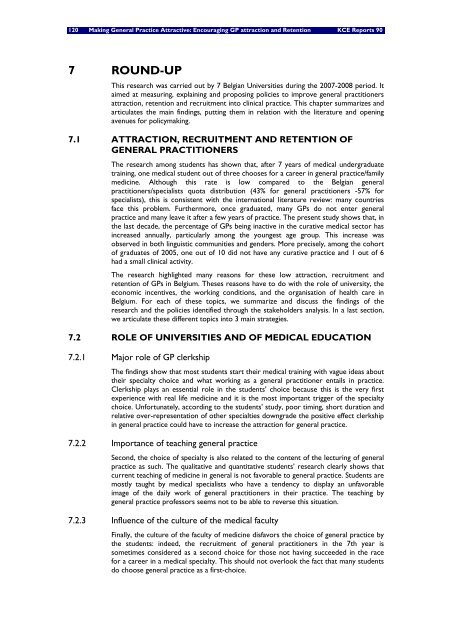Download the report (150 p.) - KCE
Download the report (150 p.) - KCE
Download the report (150 p.) - KCE
You also want an ePaper? Increase the reach of your titles
YUMPU automatically turns print PDFs into web optimized ePapers that Google loves.
120 Making General Practice Attractive: Encouraging GP attraction and Retention <strong>KCE</strong> Reports 90<br />
7 ROUND-UP<br />
This research was carried out by 7 Belgian Universities during <strong>the</strong> 2007-2008 period. It<br />
aimed at measuring, explaining and proposing policies to improve general practitioners<br />
attraction, retention and recruitment into clinical practice. This chapter summarizes and<br />
articulates <strong>the</strong> main findings, putting <strong>the</strong>m in relation with <strong>the</strong> literature and opening<br />
avenues for policymaking.<br />
7.1 ATTRACTION, RECRUITMENT AND RETENTION OF<br />
GENERAL PRACTITIONERS<br />
The research among students has shown that, after 7 years of medical undergraduate<br />
training, one medical student out of three chooses for a career in general practice/family<br />
medicine. Although this rate is low compared to <strong>the</strong> Belgian general<br />
practitioners/specialists quota distribution (43% for general practitioners -57% for<br />
specialists), this is consistent with <strong>the</strong> international literature review: many countries<br />
face this problem. Fur<strong>the</strong>rmore, once graduated, many GPs do not enter general<br />
practice and many leave it after a few years of practice. The present study shows that, in<br />
<strong>the</strong> last decade, <strong>the</strong> percentage of GPs being inactive in <strong>the</strong> curative medical sector has<br />
increased annually, particularly among <strong>the</strong> youngest age group. This increase was<br />
observed in both linguistic communities and genders. More precisely, among <strong>the</strong> cohort<br />
of graduates of 2005, one out of 10 did not have any curative practice and 1 out of 6<br />
had a small clinical activity.<br />
The research highlighted many reasons for <strong>the</strong>se low attraction, recruitment and<br />
retention of GPs in Belgium. Theses reasons have to do with <strong>the</strong> role of university, <strong>the</strong><br />
economic incentives, <strong>the</strong> working conditions, and <strong>the</strong> organisation of health care in<br />
Belgium. For each of <strong>the</strong>se topics, we summarize and discuss <strong>the</strong> findings of <strong>the</strong><br />
research and <strong>the</strong> policies identified through <strong>the</strong> stakeholders analysis. In a last section,<br />
we articulate <strong>the</strong>se different topics into 3 main strategies.<br />
7.2 ROLE OF UNIVERSITIES AND OF MEDICAL EDUCATION<br />
7.2.1 Major role of GP clerkship<br />
The findings show that most students start <strong>the</strong>ir medical training with vague ideas about<br />
<strong>the</strong>ir specialty choice and what working as a general practitioner entails in practice.<br />
Clerkship plays an essential role in <strong>the</strong> students’ choice because this is <strong>the</strong> very first<br />
experience with real life medicine and it is <strong>the</strong> most important trigger of <strong>the</strong> specialty<br />
choice. Unfortunately, according to <strong>the</strong> students' study, poor timing, short duration and<br />
relative over-representation of o<strong>the</strong>r specialties downgrade <strong>the</strong> positive effect clerkship<br />
in general practice could have to increase <strong>the</strong> attraction for general practice.<br />
7.2.2 Importance of teaching general practice<br />
Second, <strong>the</strong> choice of specialty is also related to <strong>the</strong> content of <strong>the</strong> lecturing of general<br />
practice as such. The qualitative and quantitative students’ research clearly shows that<br />
current teaching of medicine in general is not favorable to general practice. Students are<br />
mostly taught by medical specialists who have a tendency to display an unfavorable<br />
image of <strong>the</strong> daily work of general practitioners in <strong>the</strong>ir practice. The teaching by<br />
general practice professors seems not to be able to reverse this situation.<br />
7.2.3 Influence of <strong>the</strong> culture of <strong>the</strong> medical faculty<br />
Finally, <strong>the</strong> culture of <strong>the</strong> faculty of medicine disfavors <strong>the</strong> choice of general practice by<br />
<strong>the</strong> students: indeed, <strong>the</strong> recruitment of general practitioners in <strong>the</strong> 7th year is<br />
sometimes considered as a second choice for those not having succeeded in <strong>the</strong> race<br />
for a career in a medical specialty. This should not overlook <strong>the</strong> fact that many students<br />
do choose general practice as a first-choice.
















